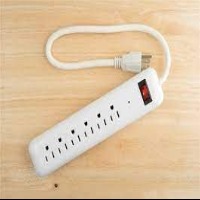What is a Surge Protector ?

Do I Really Need a Surge Protector? What is a Surge Protector, and Do I Really Need One?
Do you ever worry about a power surge destroying your household appliances and electronics? Power surges can harm all of your home’s equipment and devices. A power surge can permanently destroy your personal gadgets by frying the circuits or melting the plastic if it is large enough.
What Is a Surge Protector, Exactly?
Surge protectors are small appliances or devices that serve two purposes. The first is to allow several components to be plugged into a single power socket. The second, and more crucial, role is to safeguard your electronic gadgets from high-voltage power surges, such as your television or computer. An rise in voltage above the designated level in the flow of electricity is known as a power surge or spike.
What Is a Surge Protector and How Does It Work?
A conventional surge protector distributes electrical current to a number of devices hooked into the power strip via the outlet. The protector will channel any excess electricity into the outlet grounding wire if the voltage rises over the permitted threshold. Parallel to the hot and neutral wires are grounding wires. If the system of hot and neutral wires that ordinarily carry the current breaks down, they give a path for electrical current to follow.
What Does a Surge and a Spike Mean?
A surge is defined as a voltage increase that lasts three nanoseconds or longer. A spike is defined as a voltage surge that lasts only one or two nanoseconds. That’s it; that’s the distinction. However, if the surge is large enough, those nanoseconds, or billionths of a second, can do serious harm to a system.
What is the most common cause of a surge or spike?
Lightning is one of the most well-known causes, despite its rarity. High-power devices such as air conditioners, elevators, and freezers are among the most typical causes. It takes a lot of energy to turn on and off the compressors and motors inside.
When switching, it causes rapid, transient power demands, causing the current steady voltage flow to be disrupted. The damage usually happens in the building’s electrical system, and it might be immediate if the system is not protected, or it can happen over time if the system is not secured.
The most typical causes of power surges are faulty wiring, problems with the utility company’s equipment, and downed power lines. There are numerous points in the complicated system of transformers and lines that supply electricity to your home where an error could cause an uneven power flow, resulting in a power surge.
Is There a Difference Between a Surge Protector and a Power Strip?
It’s worth noting that not all surge protectors are power strips. While they may appear to be identical, the main purpose of a power strip is to provide additional plug space. When the difference does not come out and say it, it can be tough to tell. When you’re trying to figure out what you’re buying, glance at the packaging. On the box of a surge protector, there should be a joules rating.
The unit of energy measurement is the joule. They calculate the amount of time your appliances will be protected. The joules, or numbers, act as a reservoir. When the protector performs its duties, it suffers a hit, and the joules decrease over time. It can take just one huge surge to push it past its limitations, or it can take numerous small surges.
Surge Protectors: How Long Do They Last? How Do I Know When They Need to Be Replaced?
Keeping track of spikes and surges might aid in determining when a new protector is required. As previously stated, following a significant hit, the number of joules may be reduced and your gadgets may no longer be protected. It’s also important to know when your surge protector was bought. Depending on the amount and strength of surges, a good surge protector can last three to five years. A good rule of thumb is to change them every two years. This is because most will continue to “function” without offering protection, and you will be unaware that your gadgets are in danger.
Is it possible to use a surge protector with an extension cord?
You can technically do so if the cord can carry the same amount of energy as the surge protector, if not more. You should not, though, because it is a fire hazard. It’s worth noting that it’s against both OSHA and the National Electric Code (NEC).
Professional Electrical Or Electrician Services
Book and get the best electrician services in dubai at the best deal from Atdoorstep
For more amazing blog always read and follow Flip Posting



